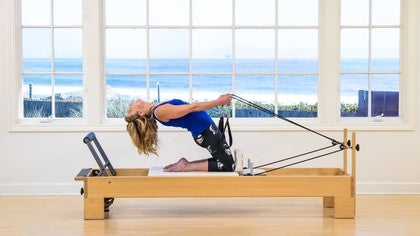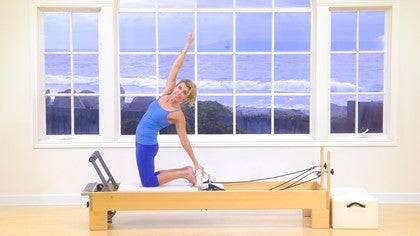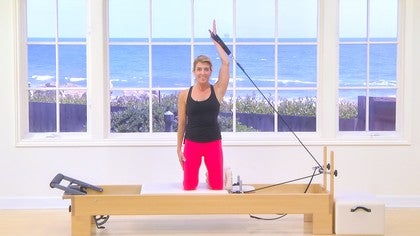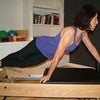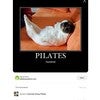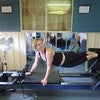Description
About This Video
Transcript
Read Full Transcript
Welcome to Pilates Anytime, welcome to this class. We're gonna use the reformer. Whether you're at home or you're not, doesn't matter, if you have a reformer without a box, you're fine. Join me in this class. I have the reformer set up on one red spring.
And if you've taken my class before you know I need this sort of initiation to touch the equipment, to touch myself, to touch the ground, and to feel where I actually need to go. I have a plan, but it could change. Come with me, inhale, just take the arms up. Scoop up the air, you're at the end of your reformer I have one red spring on. Exhale push the air away but not to push yourself down, to make yourself lighter.
So play with that I'll do two more. Inhale. Just fill up, it doesn't matter where your shoulders, your body, or anything is just fill up as much as you can so that when you exhale, you can notice that the exhalation can still leave you upright and most likely will help you stay there. One more, inhale up. Oh just shift around a little.
I know we're supposed to exhale right now but let's wait and fill it. Okay, exhale down, your head grows long your neck grows long let your head as your arms come down start to roll forward. Find the edge of your hands to the edge of the carriage. Your head, we haven't moved the carriage, well I did but I didn't mean to. Let the top of your head relax.
Hangin', like find some weight so there's over the carriage enough that you can draw the abdominals up. Not 'cause we have to, course we don't have to, we can support ourselves with our arms, but do support yourself with your arms a little and let your head hang. So you can notice what tension you're starting with, if any, I mean, maybe you're the one. Shows up to work out just 'cause they have extra energy but no tension. Alright let it hang where it settles naturally.
I'm bending my knees 'cause it's the beginning. I'm touching the bar 'cause it's there. If you don't have one don't worry about it. But stay over your feet. From there inhale as you stretch your spine.
Now, I'll bet you almost all of us leaned into that with our legs. I'm gonna leave my knees where they are, but I'm gonna pull my sits bones back and stretch my spine more forward and I'm gonna let my head hang again. Don't worry it won't move. But sometimes, almost always, if we're more free of tension, we're gonna move a lot more efficiently. So that's what I'm working on here.
I hope you do too. From here, wrap the shoulder blades, hm. That doesn't mean anything to me either. Armpits almost like they're tryna touch each other in front of your body, as you round your spine. Don't come all the way back 'cause we're going back down.
Inhale, reach the sits bones away the hands away, the spine is as long as you can feel it. But, did you pick your head up? No. It can hang fully or it can hang in line with your arms. Eventually I want you to hang it in line with your arms.
Bring it back, inhale when you're ready, exhale take it back out. Stay down here. This is where we wanna kinda try to pull our ears next to our biceps. I'm totally resting on the foot bar, how bout you? I'm gonna pull away, and now allow the elbows to bend really wide, and straighten.
This is not hard, I'm aware of that, I'm just checking in. I'm also noticing how much I turn out on my feet or roll out on my feet. So pay attention to trying to keep things sorta mechanical here in the beginning just to measure, really, just to measure. Leaving the arms straight, on your next time, hold it there. Take an inhale as your neck as long as it can be, not as rounded or lifted, but as long as it can be.
It's as if the top of your head goes to your carriage. Then exhale, roll yourself up. We deserve it. Leave your thighs where they are, if they're way behind you bring 'em back so they're over your feet. Let the arms go and roll up.
Let's take one more inhale, collecting that air. And exhale let it down. Change your springs to something you want your foot and leg work on. Balance body reformer, I play around with three full springs or three red springs, and a little bit more. That's what I'm gonna do today.
So, if you're into color three red and a blue. If you're into tension, stop it. Three fulls and a half. And that's all I got. Make it kind of work.
It's up to you, truly. I'm gonna put my head up right now, halfway on this one. And you can leave it down or up, it's up to you, and I'll do my best to remind you if we do any rolling over. Foot bar is up to the place where you can not 90, I don't really know how to tell you that part but, it's good to squat. I'm tempted to pull my bar in closer.
I sometimes do that on my own work outs, and I invited you to do the same. It works you harder but it also gives a sense of lubrication. Let's move I've got my feet heels in parallel, back is just there, shoulders down, meaning on the mat, not away from my ears necessarily, and in. Exhale, push out, pull in. It's worth it I think, well for me especially, to feel the full extension, right?
It's not locking your knees unless you actually lock your knees. Straighten your knees, and engage both sides. Think about that as we keep going. We'll go a little faster, here we go. Exhale push out one, and down.
Exhale two, I'm not counting I'm only counting for rhythm right now so don't keep track. It'll just frustrate you. Try to keep your toes coming with you. Not that they're supposed to move back and forth but just, they don't push away from you as if they're helping. Let's do one more out, then almost all the way in, and then a little pumping, we press out, in, out, in, out, in, here's the breath in, in, out, out, inhale, exhale, inhale, exhale, inhale, now exhale all the way out.
That'll end up being ten pumps if I can cue it. In any case, breathe however you want. I moved my feet down to the balls of the feet. My toes aren't fully wrapped, but I'm trying to get them relaxed. You can see 'cause my hands are moving a lot.
That's your indicator. Press out, one, take a minute, stretch out through the hips, get it long, flat, not to drop into the knees but to almost like you're gonna pull the bar towards you. Alright, here we go, inhale in. This is the slow ones, exhale out. Notice how your breathe can initiate movement, it truly can, you have to think about it at first, but eventually movement just happens 'cause it's supposed to.
And you don't have to think about it. Get the mechanics and then just be with it. Let's do two more for the sake of saying two more. One more. I'm inhaling to go down, this is that pumping.
I'm gonna do ten, it's two exhales, two inhales if you're doing sort of percussive situation. I've inhaled, right? Here we go. And inhale. And exhale.
And inhale. And exhale, all the way out, long exhale. I never got to really study, or never study with Ron Fletcher but that always reminds me of him. I learned it from Rail, but I remember that percussive timing that works. We'll see if we get it by the end.
Full extension, I turn my feet out, to the pilates stance. I still feel my tendency to tuck, I'm asking you to check yourself. Level it out a little bit, dropping the ribs. Just check out, nothin' should hurt. Exhale, full extension and finish it.
If your heels come apart you can put something between them so you have something to hold on to. But the most important thing, no, it's not important what I'm gonna say, hold on, is that you get the knees together and the legs fully extended. So do that part first, and don't worry about the heels so much yet. Okay all together we're exhaling to push out. We inhale, we pull back in, the springs are not helping us, other than we're dancing with them.
Let's do two more. That's how I count. And inhale down, here we go with starting on the exhale, it's pumping. Inhale. Exhale.
Inhale. And this is it, all the way out on that exhale. All the way, all the way, don't worry about the heels yet, get the legs fully together from the knee and up. And then if you can get the heels together, you know you can, from now on. Well not really 'cause we're changing foot positions but next time, come back.
Heels are wide, I've turned the feet out a little bit. You could go mad if you're really open with your hips. I'm gonna invite you, encourage you, please don't do that. Here we go, exhale out, stay there. Shimmy just a little bit.
I got more weight in my right foot, more in the left, right, left, right, left, right, left, right, left, right, left, I now know which one wants to lead actually I don't know, but my body does. I'm just gonna know that I taught it something there. Inhale, pull in, full extension exhale push out. Inhale, pull in, remind yourself now this is not just a front and back direction, but when you push out you are also squeezing inward. We are three dimensional.
You don't have to think about it, just know that that's what's happening. And if you want to play with certain aspects let's not play with the obvious, let's rather think about, oh I can also draw inward to go up, I don't have to just try for up. I'm gonna do guess how many more, two, one. You're in charge, I'm inhaling down here's the pumping, double exhale. Inhale.
Exhale. Inhale, pelvis stable. And out all the way. Bring it home, one more set of those. Last foot position, I'm on the balls of the feet, slightly turned out, I personally have to think heavy in the bones here, 'cause I'll grip, to just go, so I'm gonna think heavy in the bones, but then trying and engage the whatever around it to get me out and in.
Inhale. It's a simple action, and you can pull more into it or you can just do it and let the body take over, and that's sometimes how you know how to use your springs. A few more. Nice and long, and remember that everything is connected so I'm gonna have you hang out on this last one, stay here, get long as if your head was somehow attached to the other end of the room, you're holding yourself tall there without going to high heels like I just was in, and then you pull yourself back in. Let's do a couple more like that.
This sensation hopefully of a two-way stretch or elongation, or just that you're in charge and not the springs. Last one, inhaling down, let's do our pumping. Exhale one, two. Inhale three, four. Exhale, five, six.
Inhale, seven, eight. Exhale, nine, all the way on ten. Lengthening the front of the hips. Come on down. Put your feet back toward the center, sits bones distance apart, balls of the feet push out.
Elongate the front of your hip. Most likely that's where we need it. Mind that you're not hyper-extending and how you do that is not by softening, but rather engaging the back of the legs as if you're about to bend them. Then actually do, then pull yourself in, push out stay there, my bad, lower the heels, what I meant to say, stay there. Check your knees again.
Can you imagine that you're about to flex the knee, like a hamstring curl on a weight stack. It's sort of a downward press if you don't know what that means. And lift up, and flex down. And lift up, you can still be thinking about that inward pull, up, and down, and up, and down. Thinking maybe supple, I shouldn't tell you what to think.
But that's what I'm thinking, supple feet. Supple mind. Supple movement. Stay up. Check your knees, check the front of your hips.
Bend the right knee. Point it directly up to the ceiling. Press that left heel under the bar, but, you know what I'm gonna say, you're not hyper-extending, or are you, Kristi. It helps for me, to think of that wrap that sometimes you hear, around the hip. Not always, sometimes I just have to go, am I?
And change, stretch the other side. Now we'll go a little quicker right now, we go down up, I'm alternating, down up, down up, take yourself all the way to up, down up, down up. You push to the point where you're at fully straight legs because that's the only place left to go. Let go a little quicker once you get that, down up, down up. You can breathe however you want, I'm kinda trying to do that same pumping breathe.
And then on the next one take whichever foot down and hold it. Play with it a little, by that I mean maybe rolling onto the big toe or that side of your foot, trying to keep your knee still pointing straight ahead, and vice versa. So you just gonna see where you're at, I'll go back to that side in a second, let's do that on the other side. Your heel is down. You start to learn where your patterns are, when you roll the foot in and out, right.
Maybe you don't learn, but you feel something. Then what I'm gonna do is I'm gonna take whichever foot, the left, and put it right on the arch. The foot bar is right on the arch. For those of you who have really thin foot bars, this might not be a great idea. So just hang on, I'll be right back.
And I'm just letting the weight of that round bar, mine's padded so know that, press into me, and I feel it, and then I'm gonna do the other side, while I'm here. And I'm gonna just gently shift weight to the right side, the opposite side. Put weight in it. Take the other one, or unweight the other a little at least, just so you can feel those differences. Try to find level right there in the center of your foot.
Your toes are loose, your heels are whatever. I guess your heels aren't always loose by comparison but. Okay? Enough, let's come down. I'm gonna sit up, and change the springs to for me, I'm going into ab exercises, so I'm changing it to one red and one blue, otherwise known as a medium and a heavy, I guess.
Or, if you're on an AeroPilates I know that to be two full chords. Alright. Straps in your hands, hands in the center of the straps, meaning the palms in the center. You pull your knees off that way, we're gonna teach it. Draw the shoulders down for now, just lower the arms for two down and up.
When they go down are your collarbones wide? Reach further into it, lift up, do it again, one more. Okay you got that. So now we go right into curling up all the way, hold it. Check your knees, collarbones wide.
Reach forward, I'm pushing forward, not so much that it's about the shoulders, but so that I'm trying to get up, try to get up. Bend the knees come down. Exhale, curl forward. It's not about the arms it's about your spine getting up. If you can let the arms be pushed up even, a little bit.
And come back down. Curl up. So far so good, right? So just play with that if you need to. We don't want to be overly straightening down, 'cause it just becomes this weird bearing down kinda thing.
Rather just, what can my spine do with this attached to me? Curl up, stay up if you can, or you can go down. I've turned the legs out a little. I'm gonna open 'em wide. Wow that was interesting.
I'm gonna bring 'em back together, and I'm gonna bend 'em and I'm going down. Curl up again. I'm opening 'em, I turn 'em out first, I'm opening 'em, better but still interesting. What's happening for you? One more like that, curl up.
Turn the legs out, I do it from the hips, and then I don't know what happens right here but, interesting. We bring it back. Shall we make it a little more interesting still? Of course. We curl up, we open close, we bend the knees, and then we come down.
You probably want me to tell you when to breathe, I'm not going to. Up, open close, bend, come on down. 'Cause I know you have to breathe, so do it when it works. Alright I'll tell you it, how about a exhale. How bout an inhale?
If you're thinking about choreography just breathe whenever. Up, open, close. This is called coordination or it's a variation on it. One more time. Not two, aren't you glad?
And bring it down. From there, I've got one foot on the bar, I'm pushing out, I do not need to change springs for where I'm going. If you do, you'll get up but I doubt you will have to. Bending to step in with the right foot, I reach out so that I can easily step in with the left. And then I gotta futz, don't you have to futz a little bit?
Alright, heels together, we bend like a frog. Check your frog if you have a mirror, and if you don't, you don't wanna see your feet super high as you're doing your frogs here. It's just harder on the hamstrings and it's not really what I'm going for. You want your heels about level with your knee. If that works for you, press out.
Pull it back in, I know it's light. Now remember we talked about squatting, allow yourself to fold at the hip. You don't need to fold at the spine on this one. You just don't need it. Alright so pay attention to what are you able to do on this super simple exercise that everyone questions.
Can I fold at the hip? Can I lubricate that joint? Yes. Hold it out when you get back to straight. Raise both legs up but not so much that your spine changes.
I'm still on a subtle turn out but you could be parallel. Exhale, lower down, watch the knees. Inhale, circle around, make it feel good. Inhale. Less of a square, more of a circle today, but do still get your heels together before you pull down.
Alright, so get 'em together then pull down, so you know you've made that inner thigh connection prior to pulling through the hamstring. Which are not totally independent entities, again, everything is connected. Last one, hold it down when you get there, pause. Inhale, lift up. Stop.
Go back down. This time, lift up, nothing changes just like you did it a minute ago, but lift up as if there's a fishing reel right around your sternum, that's just pulling those legs up, not because a spring is doing it. You're pulling it up, you're pulling it up, you got this. Stop way before you feel your butt comin' up. Open, and around.
The fishing reel is gonna get faster. Here we go. Up, in other words we're not separating parts. We're using the parts as they are. And we're trying to find those connections.
And when you do it just starts to feel better. It's less about a map and more about a destination. Oh that's so cheesy. That's just what came out, I'm sorry, I won't do it again. One more.
Hold it. Without tightening your legs, this is a hard request, I'm asking myself too, can you lengthen the legs further? It's more thought than anything. Lengthen the front of the hips is really what I'm going for. Ease up on the hips.
But press the inner thighs tighter, as tight as you possibly can. You didn't arch your back, there's no pressure anywhere else but maybe, you're really squeezing. Open wide, separate the feet. Exhale, come back together, without tightening the tops of the legs or even the back if you can help it. But, certainly through the inner, and thinking long.
Open. Open. I'm futzing again. I want to, I'm not going to, 'cause I don't need to it turns out, turns out I'm just working into the imbalances that are there. Or I should say the asymmetries that are supposed to be there.
Maybe. I'm gonna do one more. I don't want to but I'm going to. Open. Only use what you need, check your ribs, you're not hyper-extending anything that you don't need to.
Voila. Bend your knees. Put your head rest down if it's up. And from here, push out a little so you have some sense that you're engaging the back of the legs. You're not just holding the weight of your legs up, but there's some support here.
From that place, you will allow the legs to come toward your body, your trunk, but you're also gonna let the hips curl up. Tryna keep the same shape with the legs to begin this short spine position. The short spine position doesn't mean you're dropped on yourself, but it just means that the legs are kinda in this place, eventually you do get a stretch but your abs are supporting the front. From here, we're gonna roll back down. The thighs will do what they do.
We try to get the spine down as much as we can, no one expects the full spine to be down, although I've seen it happen. What we do expect is that your heels stay together, you press the sacrum, the base of your spine down, and then you bring the feet back over. They never really change. Okay so I'll let you stretch 'em out. Bring 'em back.
Fold over. It's the spine that's bending. Your arms can be helpful. The whole arms though, not your hands. You fold over, I hit the stopper.
I actually could go higher, could you? 'Cause that's where it really ends up. You want this sense of lift through your body. The sense of I'm standing on my hands. But my legs aren't holding me up based on the springs.
I'm actually touching the stopper in this version. Then we come right back down. We melt down. You could stretch your legs out and you will see that but for now we're gonna keep 'em about the same. Bring it back, let's do it again.
Stretch out first. Re-bend, find the back of your arms as kickstands so to speak, fold the spine so the thighs come towards you, and the tailbone lifts. And you get drawn into the position. When you hit the stopper and you can still go further, keep the shape of the legs but lift the spine. And by the way you're keeping the tension in the straps, right?
So I'm not pulling on them, but they're there, they're some support if I need it. And then we melt it down. Ah. When you've gone as low as you can, you know you're gonna use the back of the legs, you bring it back to the start. One more time, press out, re-bend, fold it over, bring the spine with you ,when you've hit the stopper continue to lift but keep the angle at the knee the same.
Start to fold back down. When you get as low as you can bring it down. Stretch your legs. Yeah? Good enough.
Bend your knees, take out one foot, find your foot bar, put it on it, stand on it, and take out the other foot. Rewrap or drop the straps, and come on up. I'm gonna change the... You can actually leave the spring, I'm gonna leave the spring. You could lighten it and it just slightly changes the feel of it.
You could also make it heavier. I doubt you're gonna want it heavier but I'm going into knee stretches. If I tell you that the emphasis is meant to be on the abdominal contraction, the sense of I'm using my spine to let the breathe come out of them, let the carriage move back in, maybe that'll affect what your spring change is so that you're not working so hard, but rather feeling where it's coming from. Feet are flexed, do your best to get them right flush against the shoulder stops. And just to make it clear I have a red and a blue if I didn't say that.
Arms are on the bar and wide. Its almost like I'm pulling the bar apart. Very subtly though. Shoulders are somewhat down. Then I sit back, and this is just how I learned to get into it.
So I sit back as far as I can, and I scoop up. I haven't taken my head with me which I should, so I'll let it come down a bit, and then remember how we can both work front and back and also inwards. So now I'm thinking inner thigh and glute, I'm not actually thinking glute it just comes. Push out with the legs but keep the spine. Here's where you wanna check your collarbones, this is like a position check class.
Now, the reason the carriage comes back is because you fold from under the waist, you allow it to come back with some sense of control. Push out. So in other words I'm not changing my spine a lot, right? Hopefully. And exhale, in.
Let's go a little quicker. Play with it, inhale out, in. I'm exhaling in on purpose. It can be changed but think in push, in push. And every time you exhale you draw abs up.
And honestly, you don't even have to think that, I'm doing I don't know ten more or so. You don't have to think that you just exhale, and it happens. Feel that. Push. Push.
I said ten but I meant five or six. Hold it in. Flatten out your back. And by flatten I just mean let your hips come to sorta neutral, and your head and spine follow. Push out, same thing.
It's a different experience here, 'cause now the spine isn't moving. Pull in, push out, pull in, push out. Can you do it without much change to your spine. Let's go for four more one, push inner thighs. Two, push keep it all together, last one, come in.
From here, draw yourself forward, downward press on the bar, help yourself up, place your heels part way up the shoulder blocks. So from here, for this version I want you to feel the back of the heels in the shoulder rest. I'm not as high as I can be, I don't want you to be either. So the ankles are not in full high heels or whatever. Reach away from the bar with your legs, with your hips, with your spine, like really reach away.
Do your best. Then, with those high heels, everyone should be able to do this, right? Then, I'm gonna drop into my arms a little bit more weight. Okay this is one way to do this. So then I think inner thighs we push back, position check.
Start the exhale, yes the springs are gonna help you but make sure you're in charge of them. Push back again, inhale. Start the exhale and you draw the ribs in. You draw the abs in, whatever happens, just exhale, to control the springs coming in. You can go a tiny bit faster, right?
Inhale, exhale. So in this position we're kinda flat, and I'm gonna drop my head a little, I'm talking and I'm noticing I'm lifting it, but your ears are right in between your arms for two more. Push out, pull in, push out, pull in, hold. You're on that stopper. Theoretically.
If you have to bend the knees, okay, it's just gonna make it a little harder, you might go higher on the heels as an option. From here, we push the carriage out, we rotate around the shoulders and we find a plank. We didn't move everything so far back we can't deal. We could stay here all day. Thank goodness we don't have to.
We draw the abs in, not to round, but just to support us as we hinge back from the hips and shoulders. Inhale back to a plank. Exhale, shoulders and hips hinge. So your trunk is gonna move around those two joints, but you'll notice I'm not really gliding. In other words once I hit the plank I'm not still traveling and I don't have to travel forward to bring it back.
Maybe you won't notice that, but that's what I'm attempting to do. Let's do three more, push out, hold. You're there, you hit it. You start exhaling and you push in or pull in, and hold. Again, two, and in.
Three, and in. Hold it there. From there, we'll go straight to the elephant position. If it's available to you. If it isn't stay where we just were on the high heels.
Otherwise this is a chance to lift the toes up, to think inner thigh, to see where you stand on your feet, to drop your head again, you can even pull more weight forward over your hands this round. But if you do, you pull the ribs up higher too. Push the legs back, like really like it's heavy. Then, not just that it's lighter on the way in, you push those heels down. Push it back.
Exhale, bring it home. I always have to watch the hamstrings and knees, as you've probably guessed by now, how many times I've said it, but for you, can you dig the heels into the floor and as you go away, both directions? Come in, hold it. Come to your knees. Shake out the wrists, if you need it.
If you notice it in your elbows, we have a tutorial for that. That means you might be hyper-extending there too and you wanna engage that bicep a little bit more rather than resting. Press your feet back. This one's a good one. This is our back extension, so if I tell you that, by back extension I'm not usually trying to work your low back, that will happen, and I'm happy for that, but we're looking for the work to be in the upper back.
Not an easy place to do it, but keep it in mind. As best you can you flex your toes, get the feet as close to the shoulder rest, hands on. For me, especially if I haven't done it in awhile, I have to roll into it, I tuck. I roll, I find it, and when I know I can't press my pelvis anymore forward, without also feeling like I'm tucking, I then take it into my upper back. By the way, Sarah taught me this, Sarah Bertucelli, push the heels into that shoulder rest.
Or at least I heard it when she said it. Push back, inhale, nothing else changes. And up. Oh ya know what you're gonna like this better with it lighter. You don't have to but you might like it better.
Inhale, back. Exhale, up. I'm gonna change the breathe in a minute so don't worry if you don't have it now. Just pick one. Inhaling back for now, exhaling up.
My inner thighs matter right here. Now, I'm gonna inhale here 'cause I can lift taller, I can almost take my hands off the bar. Exhale back. Inhale in up. Exhale back.
Again you're always looking for that opposition. I don't know if I said that enough to say again. But, you are. I'm pushing the shoulder rests away even as I go forward. One more time.
Come in, you're there, don't give up yet, you're still in the shape. You can keep the shape and walk up to your finger tips. You're on the stopper, you're still pushing the heels back. You can lift the arms up, way up. Hamstrings, if they're not working you're hurting yourself.
Oh, good. And bring it down. So moving on to some side, some arm, some back, so you can get on with your day. So, I did lower it, so I'm now on one spring. And if you did it with me, I would encourage that, and it does depend on which apparatus you're on.
So make it feel lik you're stable. Sit on your reformer. In a figure four like position. Your hand.. Is somewhere near the middle.
There's too many variables for me to tell you exactly where it should be. It depends on where you set it, how long your arms are... I got long arms. So I'm ever so slightly forward, and also for shoulder reasons. So I can easily lean away from it, have a straight arm, and allow my shoulder to be down without a massive force.
That's what I hope you find too, even if you're closer to the bar, however it looks it doesn't matter. Here we go. We use from underneath that arm we just talked about. We try to find our head in line with the bar. Theoretically the other arm just floats up and is easy.
From that place we rotate the ribcage, we bring the arm with it because it happens to be attached. Then, again, Sarah taught me, push that shin into the shoulder rest and find your opposition, so that really you're just finding space. Re-open. And come back up. I'll stretch later, let's go again.
From underneath that armpit if you will, lat, whatever. Rotate. Turn. You don't get that many a these, so, milk it. In fact you get one more for three.
Pressing out, I'm using what I have but not more than I need to, at least that's my attempt. Ribcage turns. Stay here. I'm coming close enough that you can actually weight the opposite arm, the one that was just floating through the air. And adjust it so that both arms are about shoulder distance.
From here, this is our next back extension. It's a downward, even slightly outward press of the palms. But also with the shin into the shoulder rest to find that arch. And there's not doubt about it I'm doing a little bit of a push with the back arm and a pull with the front arm. But both are downward pressure more than that.
Push out, particularly here. Take the stretch, be nice to yourself. As you come up see if you can do it mostly from the back extensors, that means you lift your head, you lift your neck, you know follow that like a string of pearls, and then the downward pressure of the arms just helps you as you go. But mostly it's the back. Was that three?
No, here's three, take it down. See what you can do without the spring. Lift your head. The spring will help you, it'll come with you. I'm still pressing into the shoulder rest.
Up, oh that feels so super good. I'm actually gonna exaggerate it more in that direction I said I'm gonna pull with one, push with the other. Only 'cause it feels good, I'm not really trying to change the hips much. I bring it back, level everything out as best I can. Take it down, bring the back hand more toward the center or forward of that.
Re-open, and up we come. Find a shoulder rest, a grip, a leg. Lift up, and stretch over. Flair, flair that outside edge. It means you have to contract the inside edge.
Try not to rotate for now, up up up. Let's just change sides. Sitting comfortably as best you can, just so you know, you can elevate your hip in either side, whichever feels good, but you can also lean away from it, just do your best. Here we go. Shoulder down, we press out.
I have connection with both ends. Exhale, rotate. Inhale, open. This side is not as obvious for me. Coming up.
In terms of what's actually turning me. I'll explain, or try. It's the ribs that I'm trying to turn, theY don't move as easily so it sorta feels like my arm takes over sooner than it maybe should. So I get to know that. Number three.
Head in line with the arm, hopefully. Exhale. We came back open, we opened up, we're gonna go down and stay down on the next one. Here it comes. Inhale, find that line.
You're not reaching so far out that it hurts, nothing feels unstable, well, that's not true. But pay attention to what does and honor that. I separated the hands a little bit more. I'm pushing into the shoulder rest with that backward shin, and lifting up. And I'm rethinking about the back extensors because I really just wanna stretch my hip right now.
So I'm gonna drop weight into both arms, I'm gonna lift my head and the reason the spring moves is because I'm back is bending even as I push into the shoulder rest. And come back down. This is it. Sort of. Push into the shoulder rest, I'm gonna do mine over, you keep going.
Lifting through the head. We take it back down. Adjust the hand that you moved earlier toward the middle or more forward of that. So that you know it's in place that you can let go of the forward arm, open up, and come back in. Find the shoulder rest, find the peg, whatever you need, to lift the other arm, if you can get it right next to your ear, and I tell you what, that took me a long time to be able to do.
So I'm encouraging you to do it because I didn't think it was possible. Lift the ribcage make it as flaired and strange as you want, drop the other shoulder and arm, and help yourself on over for a nice expansive breath to the open side. Just when you thought it was over, it's not. We're almost there though. So I'm keeping it for myself to one red spring right now.
You may decide to move it to a little bit heavier, and that would probably have to do with more height and or weight, than 5'4", 120ish. Okay so it really depends. You should feel secure. That's the thing, you have to decide, what can you feel secure with, if you don't know the exercise which is kneeling chest expansion, you're gonna watch it first 'cause you care about your body. And I'm saying that 'cause it's a little unstable here.
Especially if it's light, and light is good. So, knees are at the shoulder rest for this version. I will do my best, and this is where it gets a little tricky to press my hips over my heels. I know when they're there because I feel the backs of my legs more. I know when I feel more secure when I use my inner thighs and my abs involved.
From there, arms are easy, they're straight though. And we pull straight back, we hold. We just reach forward, we don't let go, that'll drop you to the middle of that frame in a second. Okay so you are knowing that you are gonna take your arms forward. You don't have to think too much more about it, just stay in the position, keep the shape, and you'll probably be just fine.
If you think it's about from here to there, I'm gonna worry a little. If it feels jostley to you, check in, are you now, if ever you were gonna lock anything, now would be the time to do it with your arms. Inner thighs, don't just rely on the butt. It won't feel good, and you won't work your triceps and back as much. One more time.
Take it back, hold it back. Check that you're not leaning back, don't hurt yourself to test it. Oh can your arms be any closer to your body? Apparently mine could, 'cause that was a huge difference. Bring it back.
Alright while we're here, and this'll probably end it for us. So, this is an option, if this does not work for you, it's gonna involve some hinging at the knee joint, if that doesn't work for you, you're gonna go to the mat now and do either just basic back extension, which you can find on the website if you don't know what that is already, you probably do if you're in this class, or swimming, anything else like that where you're longer and flatter. Otherwise, we're gonna hinge the hips a bit for this next couple, and then we'll be done. We hold the straps. We're next to the shoulder rest, nothing really changed.
We draw the pelvis under, more exaggerated, so you trust it. The collarbones are wide, I didn't change the springs, although I kinda want to. As I go back I'm hinging back, it's the thigh hinge, just like before press the shins into the carriage and come back up. Take your time if you need to add that spring back on. A half a spring or a little bit more is totally appropriate.
Maybe even necessary depending on the reformer you're on. I'm gonna hang out with it, and make myself do it as if I was on the mat. I tuck, I actually have to look down sometimes to know I've done it. 'Cause otherwise it just doesn't happen, and it matters. I'm bringing the back of the thighs to the calves, or close to them as I can.
And then as I lift up, I come up, voila. Two more of those, although I'm gonna drag it out. Go figure. But I'ma try to add a little back extension on it. So it won't go as far.
I'm a pull a little, so I know I have help. I'm not as scared as I look, so I'm gonna open up the collarbones. I reengage the glutes, and everything's working for me so that I hinge back maybe a little less than before, or a lot less than before, and I extend the spine. And I bring it back. And up I come.
And I pull a little bit again. You can pull a little more if that was super light. I think I'll pull a tiny bit more this time. Reengage so I feel front and back, I hinge back, back of thighs towards calves. Then, nothing really changes except the upper back.
Bring it back, and up we come. Now, we put those down. I'm gonna play with one last piece that that works with. Again, this is the same idea so stay on the floor if you're there. And do either a rest or a few more in a moment.
We're gonna pick up the right arm. We're gonna turn the ribs just like we did with swan or when we do on the mat. We reach back, we look for the bar. The other arm went up for balance. We come back.
Everything stays straight, we find contact with the front of the thighs again. On the shoulder rest, and come back up. It's a big departure from where we've been so make sure you were comfortable with the one before it. Left arm is up, or front hand is up. As I rotate I'm trying to keep my thighs right up next to the shoulder rest until I can hinge back and find that bar.
It's an underhand grip. Hinge back. Come up. Then it is not a push off the foot bar, rather a reach from the top arm. Woo.
Thank goodness I'm on an only two more theme. Up, find it, look for it, know you're gonna land it. Otherwise don't do it. There's more, believe it or not. Up you come, you're not pushing off, you're guiding everything forward and you're strong enough to lift off.
And come back. If not you practice those other things. Last one. Find it, know it, trust it. And up.
Reach through the top arm. And rest, however it suits you. Now go do something with your day. Thank you.
Pilates with Kristi Cooper: Reformer Workouts
Comments
You need to be a subscriber to post a comment.
Please Log In or Create an Account to start your free trial.

